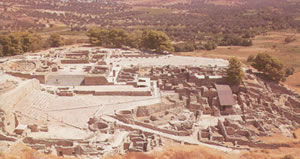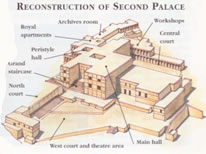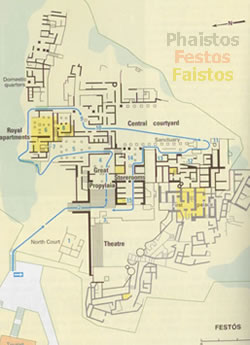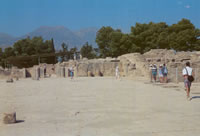
 Phaistos (Open daily 8am-6pm;
3.55 euros) is located 62 km south of Heraklion in the Messara valley in the municipality of Kamilari. Thrilling views of the Messara plain and Mt. Idha/Psiloritis from the hill
on which it was built. Phaestos was the second biggest palace city of Minoan Crete, and after Knossos, the second most important Minoan palace city. It was a
fief of King Minos' brother Rhadamanthys, and birthplace of the sage Epimenides. Excavated by the Italian Federico Halbherr (involved also in early work at Gortys) early 1900s
(when Evans was excavating Knossos). Almost no reconstruction was done here, in sharp contrast to Knossos.
Phaistos (Open daily 8am-6pm;
3.55 euros) is located 62 km south of Heraklion in the Messara valley in the municipality of Kamilari. Thrilling views of the Messara plain and Mt. Idha/Psiloritis from the hill
on which it was built. Phaestos was the second biggest palace city of Minoan Crete, and after Knossos, the second most important Minoan palace city. It was a
fief of King Minos' brother Rhadamanthys, and birthplace of the sage Epimenides. Excavated by the Italian Federico Halbherr (involved also in early work at Gortys) early 1900s
(when Evans was excavating Knossos). Almost no reconstruction was done here, in sharp contrast to Knossos.

 Many elements in common with Knossos: huge clay pots for
storage of oil, large courtyard with huge stairway ascending from it, theatral area, but at Phaestos, one finds also the remains of a furnace used for metalworking. Potters and
carpenters seemed to have used the same area of the palace as well. Same layout as at Knossos, with a central court with wings around it. Unlike Knossos, few frescoes found
here though the walls were covered instead with white gypsum. Marble and alabaster are present as well. A large dining hall overlooked the court. Parts of older palace( which
was destroyed at end of Middle Minoan period) have been successfully excavated. Most likely there are missing buildings in the palace complex as evidenced by a collapsed
section of the central court. A Tourist Pavilion , below ground level, leads into the palace from the northwest corner. From there one enters the West Court and Theatral
Area. The former may have been part of the older palace, along with a low wall in front of the Grand Stairway, which may have been the old palace facade. The Grand Stairway
consists of twelve stone steps, some of which are carved from the hill itself and are higher in the middle than on the ends, an innovation used 1200 years later in the Parthenon
(Athens Acropolis). Small rooms lead into larger rooms and out onto descending stairs to the Central Court. Down below are storerooms with the usual clay pit hoi (huge pots).
The floor slopes downward towards a drainage hole.
Many elements in common with Knossos: huge clay pots for
storage of oil, large courtyard with huge stairway ascending from it, theatral area, but at Phaestos, one finds also the remains of a furnace used for metalworking. Potters and
carpenters seemed to have used the same area of the palace as well. Same layout as at Knossos, with a central court with wings around it. Unlike Knossos, few frescoes found
here though the walls were covered instead with white gypsum. Marble and alabaster are present as well. A large dining hall overlooked the court. Parts of older palace( which
was destroyed at end of Middle Minoan period) have been successfully excavated. Most likely there are missing buildings in the palace complex as evidenced by a collapsed
section of the central court. A Tourist Pavilion , below ground level, leads into the palace from the northwest corner. From there one enters the West Court and Theatral
Area. The former may have been part of the older palace, along with a low wall in front of the Grand Stairway, which may have been the old palace facade. The Grand Stairway
consists of twelve stone steps, some of which are carved from the hill itself and are higher in the middle than on the ends, an innovation used 1200 years later in the Parthenon
(Athens Acropolis). Small rooms lead into larger rooms and out onto descending stairs to the Central Court. Down below are storerooms with the usual clay pit hoi (huge pots).
The floor slopes downward towards a drainage hole.
 The Central Court is
certainly the most interesting sight in the palace with its view of the Psiloritis mountains. These views were, however, most likely blocked during Minoan times by second
stories on either side which are no longer standing. Still the court is appealing, with its great doorway on the north end with its half-columns, niches, and painted plaster.
A covered portico runs along the longer sides of the courtyard. On the edge of the site are the ruins of a classical Greek temple. One cannot see much of the Royal
Apartments (reached through the north door) which have been closed off for their own protection. The Peristyle Hall, a colonnaded courtyard open in the middle, was open on
one side to a view of Psiloritis. Other buildings include the Archive where the Phaestos Disc was found (see Heraklion Archaeological Museum) and the Peristyle House , likely
a private home.
The Central Court is
certainly the most interesting sight in the palace with its view of the Psiloritis mountains. These views were, however, most likely blocked during Minoan times by second
stories on either side which are no longer standing. Still the court is appealing, with its great doorway on the north end with its half-columns, niches, and painted plaster.
A covered portico runs along the longer sides of the courtyard. On the edge of the site are the ruins of a classical Greek temple. One cannot see much of the Royal
Apartments (reached through the north door) which have been closed off for their own protection. The Peristyle Hall, a colonnaded courtyard open in the middle, was open on
one side to a view of Psiloritis. Other buildings include the Archive where the Phaestos Disc was found (see Heraklion Archaeological Museum) and the Peristyle House , likely
a private home.
Heraklion Prefecture Crete Continued1 | 2 | 3 | 4 | 5 | 6 | 7 | 8 | 9 | 10 | 11 | 12 | 13 | 14 | 15 | 16 | 17 | 18